It’s known as the ‘Hidden Gem of Blackpool’. The history of The Grand Theatre in Blackpool is long and lively and dates right back to 1894.
On 23 July 2019 it celebrated 125 glorious years! If only the walls could talk…
You can make a donation to the Grand Theatre by phoning the Box Office on 01253 290190 or via their website: www.blackpoolgrand.co.uk/donate
- 1894: The Grand Theatre Opens in Blackpool
- 1940's: The Golden Years of a Year-Round Playhouse
- 1950's: A Glittering Decade
- 1972: A Proposal for Demolition… and the Saving of The Grand
- 1980: Rebuilding the audience at The Grand Theatre
- 1981: Royal Variety Performance
- 2019: Celebrating 125 Years
- 2020: Surviving Covid-19
- Blackpool's Grand Theatre Today…
- 70 Fascinating Facts – History of the Grand
- While you’re here…
1894: The Grand Theatre Opens in Blackpool
The Theatre’s rich history began way back in 1894, when it opened on 23 July. Leading Victorian theatre architect Frank Matcham designed and built it, for Blackpool’s first successful theatrical manager Thomas Sergenson. He always described it as ‘Matcham’s Masterpiece’.
Did you know? The Grand Theatre opened just two months after the Tower.
The theatre took just nine months to build. It cost Sergenson £20,000, which in those days was a lot of money. He’d earned some of his money by operating two small rented theatres. He also staged a circus for five summer seasons on the site of The Grand. These cottages and shops (below) were demolished in 1889. They once stood on the site of The Grand Theatre, later to be replaced by the Grand Circus.
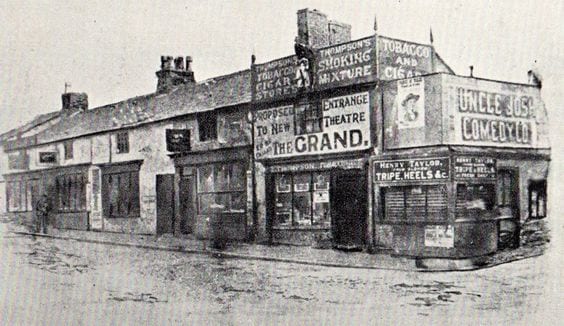
Grand Theatre Firsts
- The Grand Theatre was the first theatre in Blackpool designed and built to be fully electric.
- Recent research with a theatre historian revealed that there was a backup gas light system installed in case the electricity supply failed (as it often did). The House Manager controlled the gas system with a panel in the Box Office. The panel’s long gone – but the gas main still exists.
- It was the first to have a fully cantilevered circle eliminating the need for pillars to give every seat a clear view.
- Matcham invented the crash doors to enable a quick evacuation of the building.
Matcham’s Masterpiece
The Grand Theatre is still known as ‘Matcham’s Masterpiece‘. The name’s even more deserved now that there are few surviving examples left of the work of Frank Matcham. This particular masterpiece offers ornate, gilded plasterwork, baroque ceiling, and cavorting cherubs.
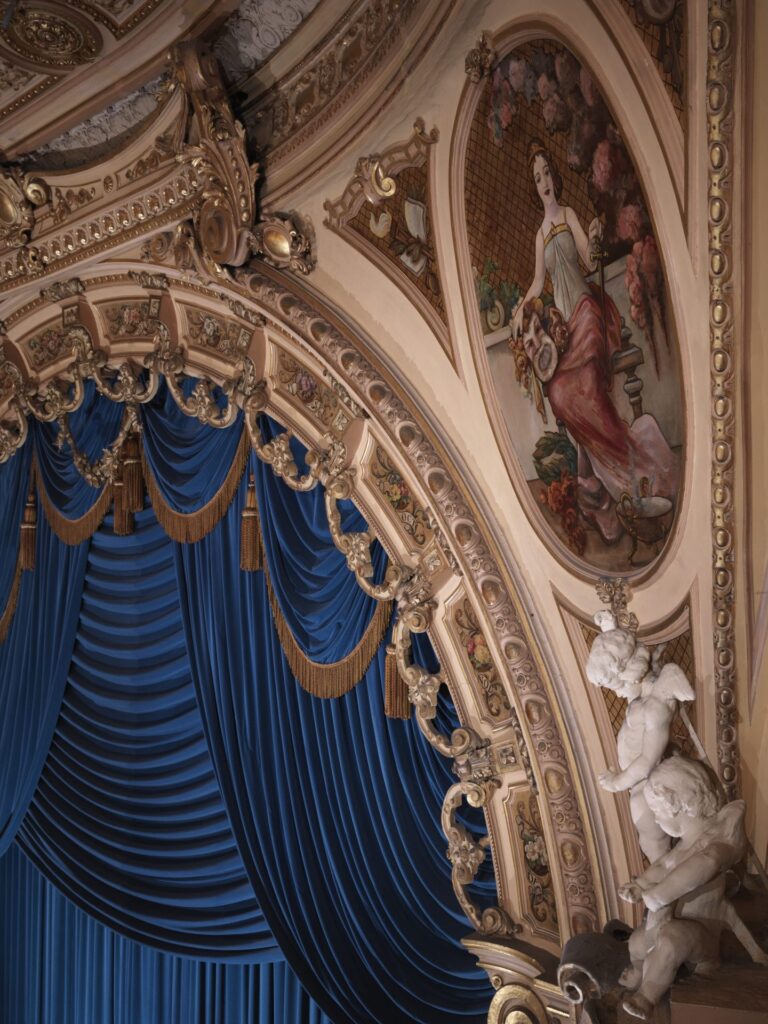
Cantilevered balconies give every seat a clear view of the stage.
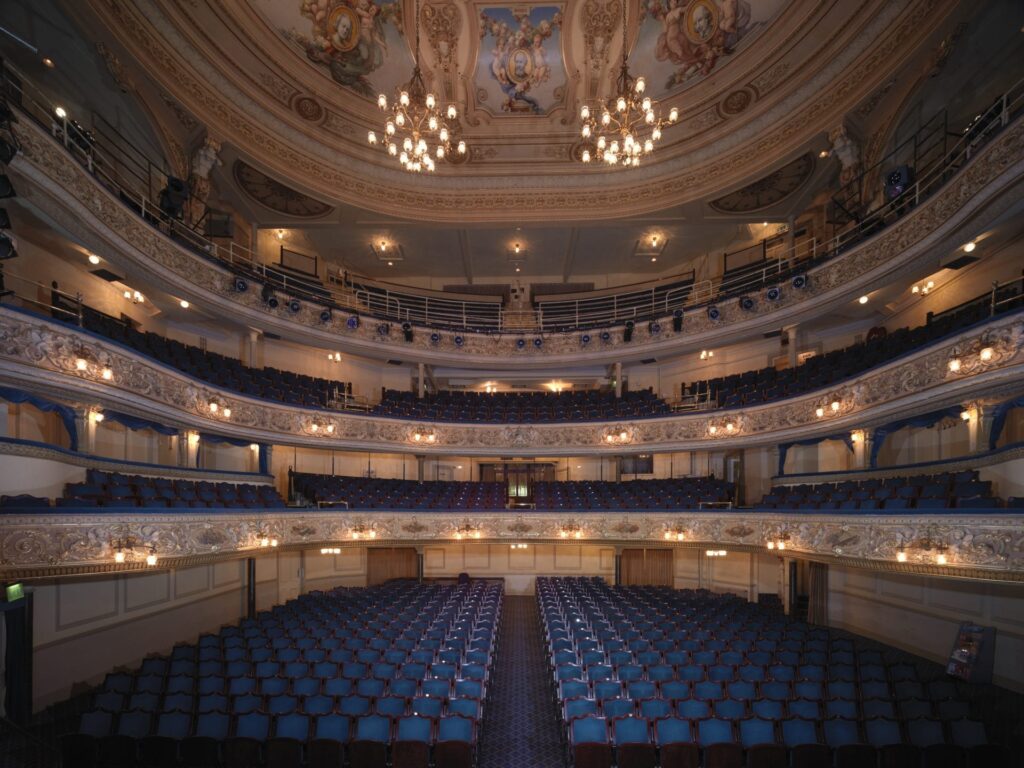
During his fifteen years at The Grand, Sergenson presented many great stars. Big names like Ellen Terry, Madge Kendal, Sarah Bernhardt, Lily Langtry, F R Benson and Dan Leno.
In 1909 he sold the theatre for a handsome £47,500 to the Blackpool Tower Company. They looked after The Grand for the next sixty-two years.
More ‘Firsts’ in the History of The Grand Theatre
- The Grand was the first Blackpool theatre to present the two big musical hits of World War One. The Maid of The Mountains and Chu Chin Chow.
- Big American musicals were popular in the 1920’s like Rose Marie, The Desert Song and No No Nanette.
- Top West End producers began using The Grand for British premieres. For forty years many plays and musicals showed at The Grand ‘prior to London’.
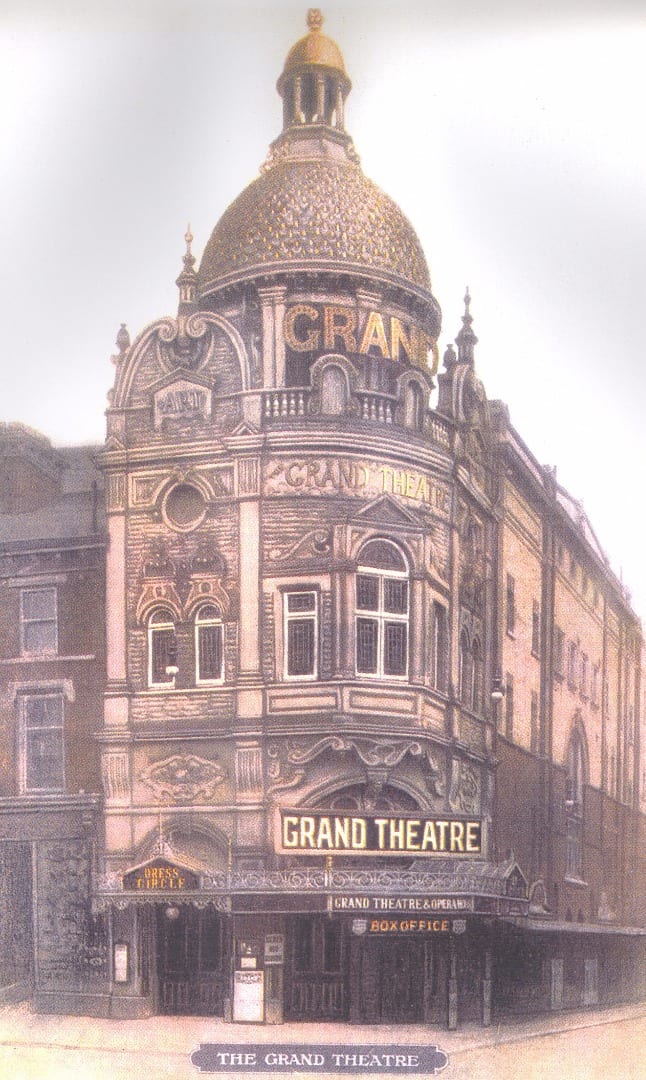
Did you know? Charlie the Victorian ghost is said to haunt the Upper Circle. He was in love with a ballerina – but she wasn’t in love with him, so he threw himself off the balcony!
- After the success of talking pictures, in the 1930’s, The Grand became a cinema in the winter with ‘live’ shows during the holiday season.
- Most famous in the 1930’s was Gracie Fields. She made all of her Blackpool Variety appearances here, between 1932 and 1938.
1940’s: The Golden Years of a Year-Round Playhouse
The Tower Company began building the new Blackpool Opera House in 1938. It was now that The Grand returned to its role as an all-year playhouse.
The first summer season show was a variety revue held in 1940. It starred local comedian Harry Korris. He returned the following summer with a stage version of his famous Happidrome radio show.
In October, 1942, Noel Coward premiered and appeared in two of his plays.
During World War Two, Blackpool was a safe haven from German bombing and many great stars and shows came to The Grand. There were visits by Gielgud, Evans, Ashcroft, Harrison, Vivien Leigh, Flora Robson, Robert Donat, John Mills and Emlyn Williams.
Did you know? That many famous people have appeared on Grand Theatre’s stage. It was even rented for a political rally in 1902, with main speaker MP for Oldham, Winston Churchill.
1950’s: A Glittering Decade
The prestige of The Grand continued through the 1950s. It was a glittering decade in spite of the growing impact of television. Holiday-makers of the 1950s and 1960s best remember the highly successful summer seasons. Comedy favourites like Arthur Askey, Thora Hird, Glenn Melvyn, Danny Ross, Hylda Baker, Freddie Frinton, Sid James and Jack Douglas all appeared here.
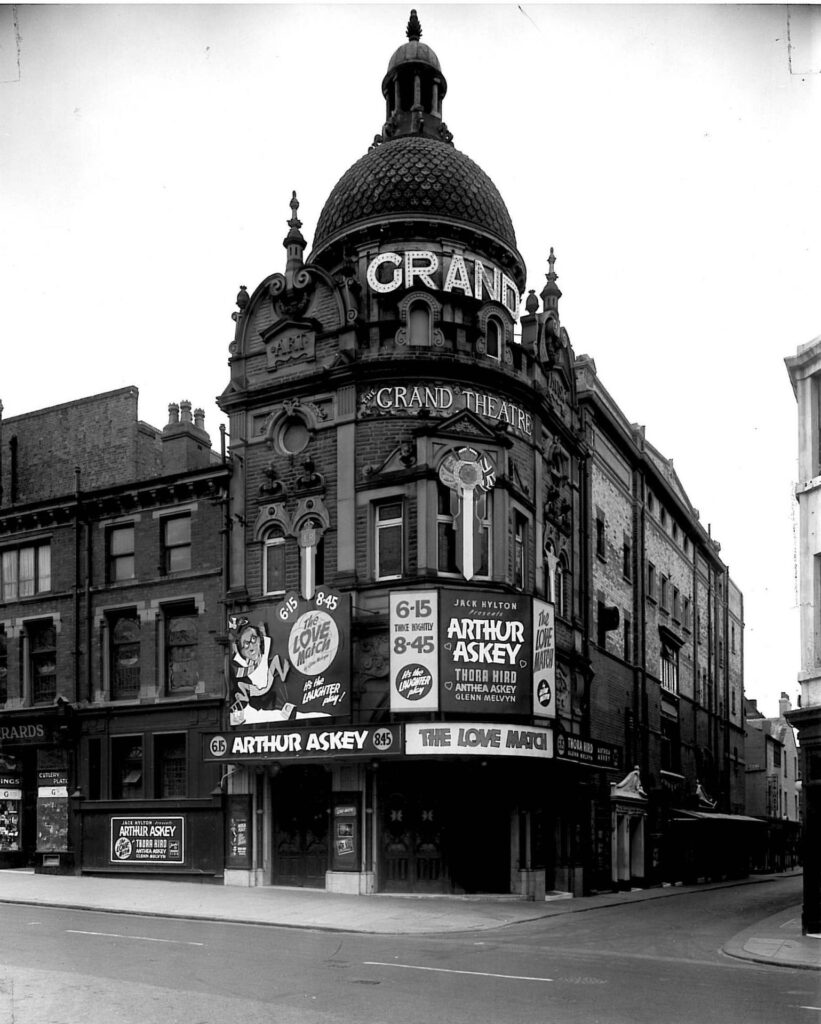
By the early 1960s theatres across Britain were closing due to loss of audience to television. The Grand survived longer than most, thanks to the backing of the Tower Company.
But the shortage of good shows, coupled with declining ticket sales, forced a policy of winter closure from 1963. Fewer big names came to the theatre, although the summer seasons still made money.
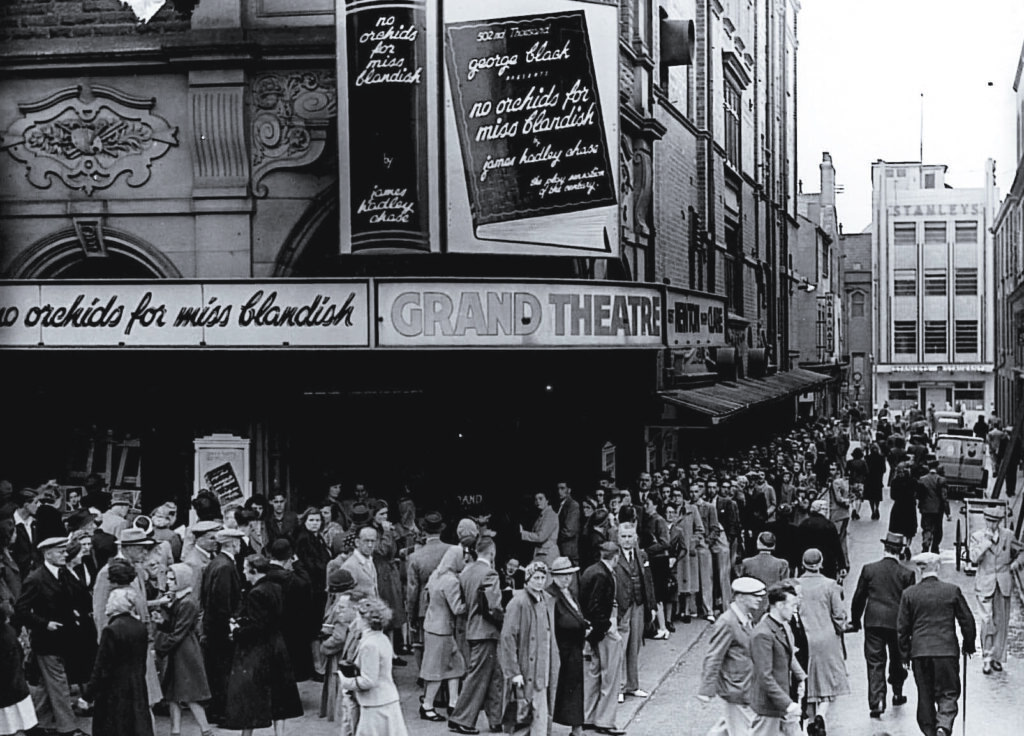
If you like looking at old photos, take a look at our ‘Old Blackpool’ board on Pinterest
1972: A Proposal for Demolition… and the Saving of The Grand
A town centre redevelopment plan of the mid 1960s included the site of the theatre. The result of this was that in July 1972 the Tower Company applied for permission to demolish it. In its place they proposed a department store…
However, a successful application to the Department of the Environment, saw the theatre listed as a Grade II building. Because of that, there was a full public enquiry.
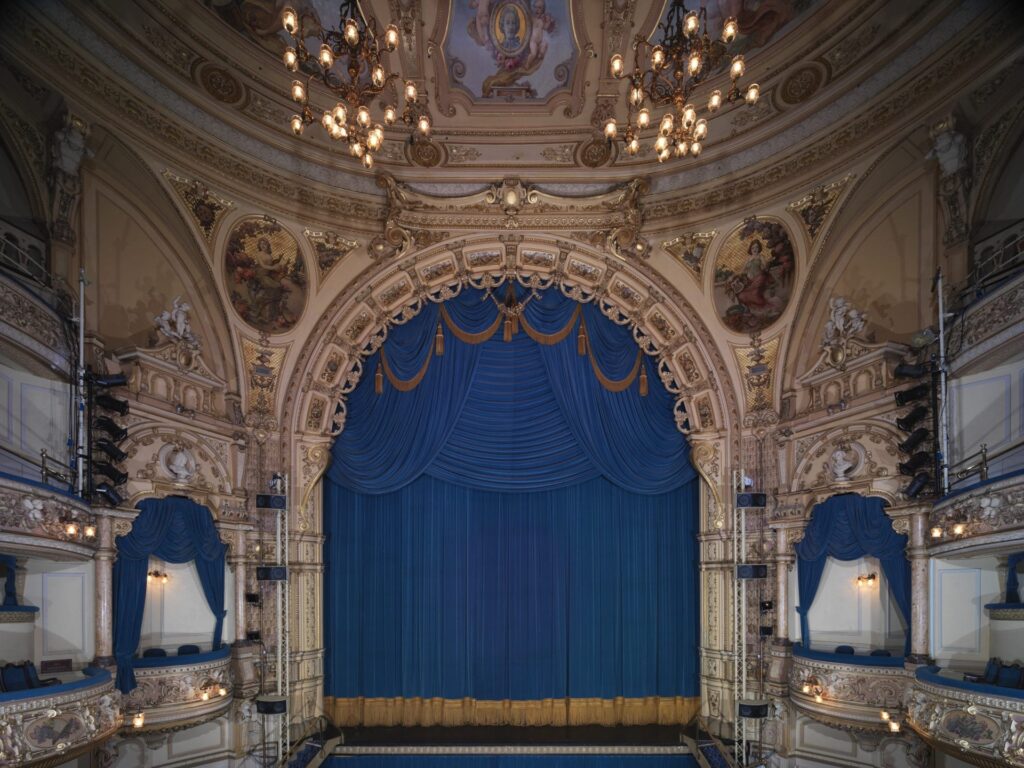
In early 1973 a meeting at a local hotel saw the formation of the Friends of The Grand, specifically to resist the application. By now the Local Authority were also supporting the plan.
In 1975, after years of disuse, it became apparent that the Tower Company were planning to turn The Grand into a bingo hall.
Yet another round of legal and financial wrangling followed. The Friends of the Grand, together with EMI and the local council, put together a deal to lease the theatre for £10,000 per annum and final purchase for £250,000.
It reopened on 25 July 1977 with Noel Coward’s play Fallen Angels.
1980: Rebuilding the audience at The Grand Theatre
After the eventual purchase of the theatre by The Grand Theatre Trust, a new chapter began in September 1980 in the history of The Grand.
Dozens of ‘Friends’ helped to refurbish the dressing rooms and backstage areas in readiness for the reopening in the week of Monday March 23, 1981. The first production saw Timothy West and Prunella Scales in the Old Vic production of Shakespeare’s The Merchant of Venice.
Did you know? In 2000, a whopping 2 tons of dust and dirt came off the ceiling during restoration work. A triple layer of dust, tobacco smoke and yellowed varnish had preserved original colours underneath.
In May 1981, Blackpool Grand Theatre had a prestigious two-week visit by the D’Oyly Carte Opera Company with their Gilbert and Sullivan repertoire.
1981: Royal Variety Performance
Then on Friday 29 May 1981 the ultimate theatrical honour of a Royal Variety Performance in the presence of HRH King Charles III (the then The Prince of Wales).
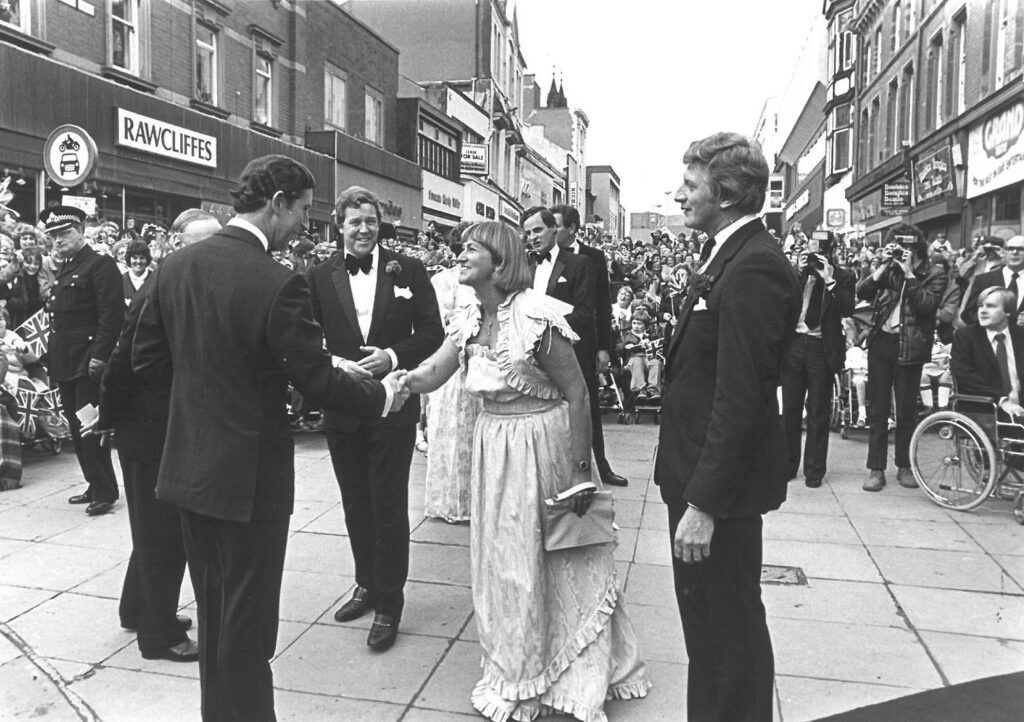
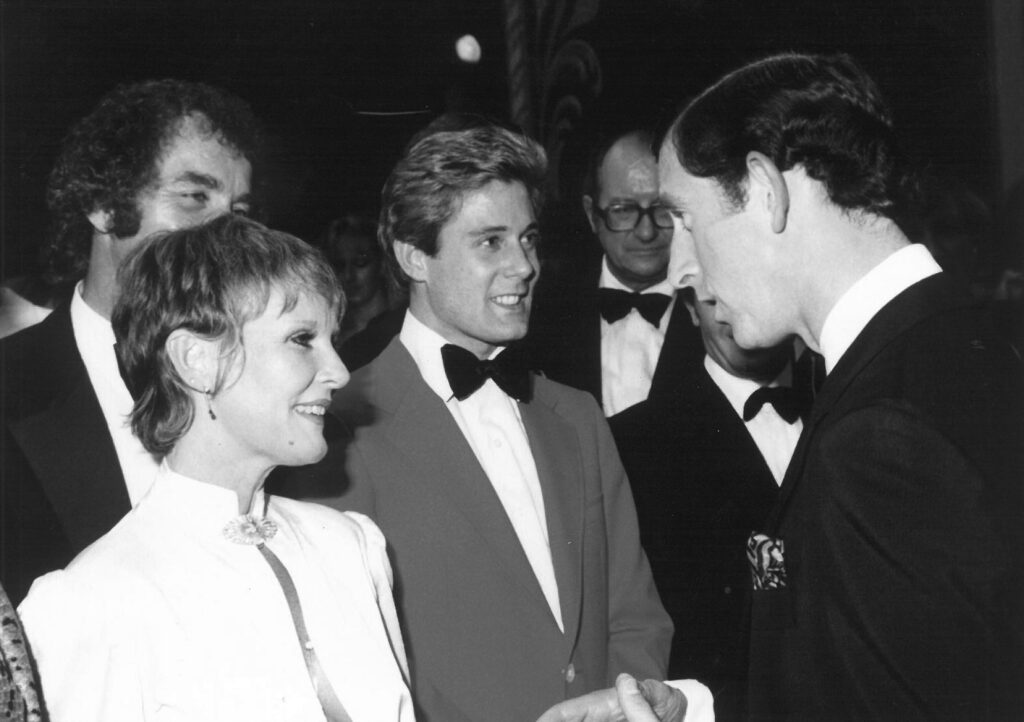
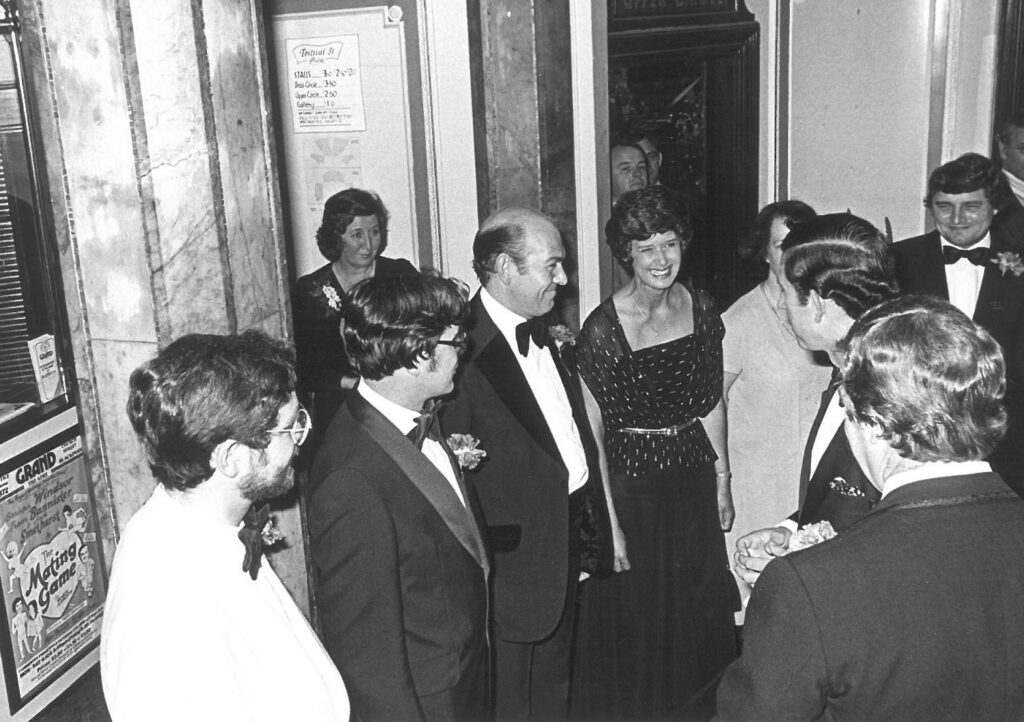
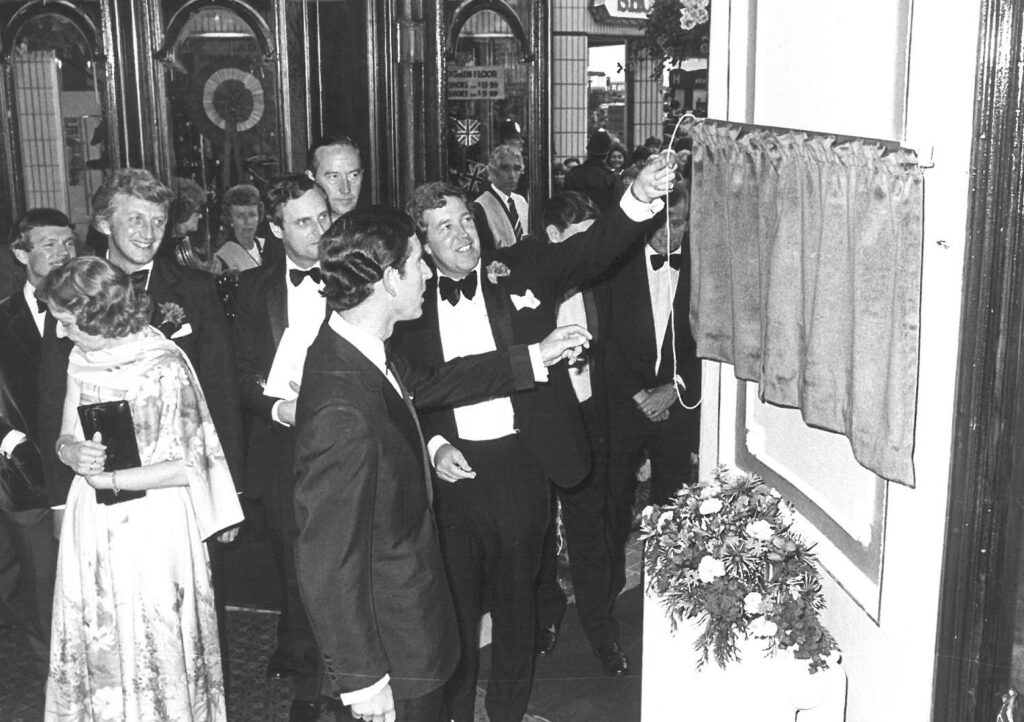
The Royal performance produced by Robert Nesbitt included such stars as; Barbara Windsor (who also starred in the summer show that year The Mating Game), Anita Harris, Ray Cornell and his Dancers. Danny La Rue, Petula Clarke, Lennie Bennett, and local chorus Blackpool Operatic Players. Plus Blackpool and Fylde Light Opera Company and Thornton Cleveleys Operatic Society, all hosted by then TV legend Russell Harty.
The audience for weekly theatre had gone during the nine-year closure. But slowly won back, audiences grew throughout the 1980s. With a varied programme of plays, dance, musicals and concerts, The Grand has proved that there is a healthy demand for the arts in Blackpool and the surrounding areas.
2019: Celebrating 125 Years
The 125th anniversary celebrations in 2019 began with a glittering season launch event. A host of guests including local businesses, Friends of the Grand and big names were there. Visit Fylde Coast went along too, to hear about the new campaign to restore the roof of the beautiful dome.
The Grand Theatre is still going strong, but time and weather have taken their toll. As it celebrates this important milestone, the challenge is to raise £125,000 to repair storm damage to the dome at the front of the building.
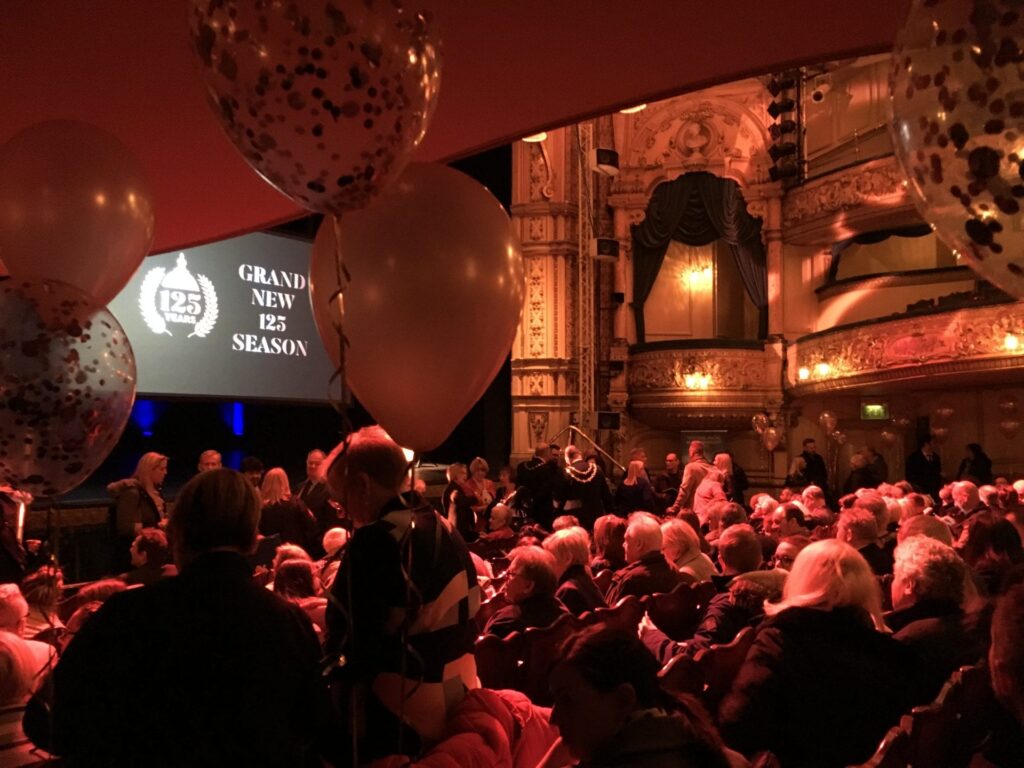
The decorative copper tiled roof and iconic pineapple suffered damage in 2018 from Storm Doris. Slates were blown off the roof along with a number of pineapple leaves.
The dome has been part of the Grand since it first opened its doors. Built with an oak frame, 980 copper fish scales cover it. And the pineapple at the top has 42 copper leaves. Funds raised will go to repair the dome. The theatre wants to raise more money though, to fund more improvements and improve accessibility.
2019: PEOPLE POWER. A ‘Grand’ March Recreated 45 Years On…
In the 1970’s, the Friends of the Grand formed to help to save this wonderful building from demolition…
On Sunday 15 September 2019, Blackpool’s Grand Theatre recreated an iconic image from the 70s.
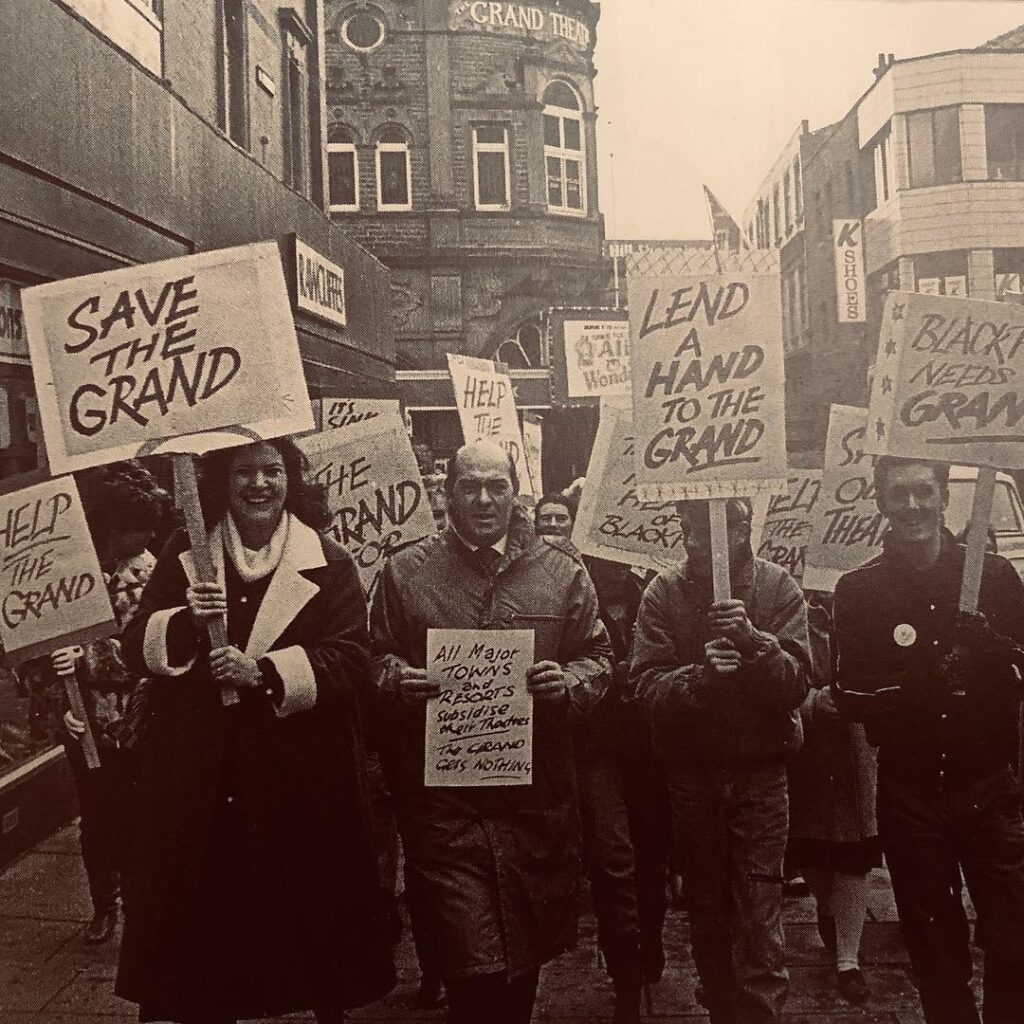
For Heritage Open Days 2019, Blackpool Grand focussed on the incredible fight by the Friends of The Grand. They saved this Heritage icon from demolition to make way for a Woolworths! The Parade saw over 70 members of the public came to ‘Support the Grand’ and create awareness of this beautiful theatre.
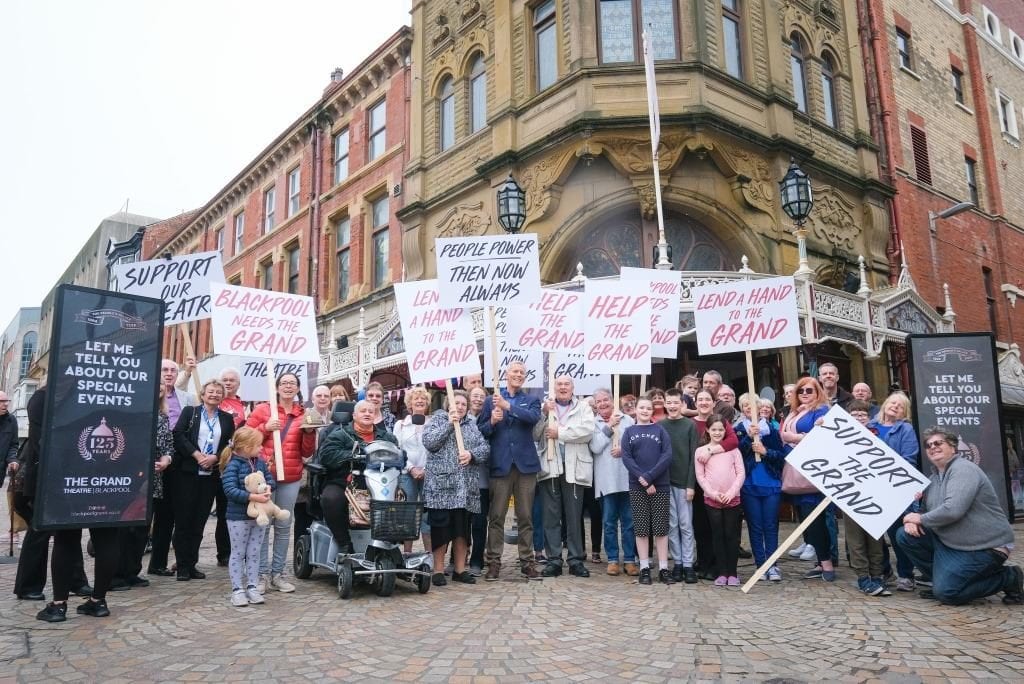
Ruth Eastwood was Grand Theatre Chief Executive at the time. She said ‘As custodians of such a great building we believe it is important for the theatre to be in great shape for future generations. Having so many involved shows how much passion people have for the theatre. And how important it is in the lives of the community, and how many memories it holds.’
2019: New Show Celebrating 125 Years!
In 2019 Blackpool Grand Theatre also launched its own brand new production company – Blackpool Grand Productions Ltd. The home-grown summer show, part of the 125 year celebrations, was the first produced in-house.
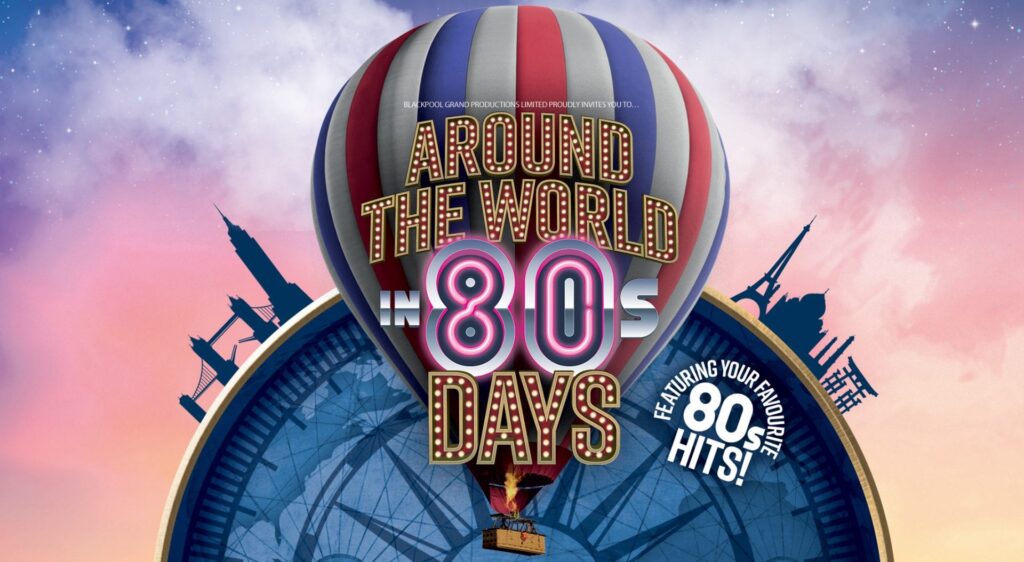
Around the World in 80’s Days was a musical adventure! The WORLD PREMIERE of one of the greatest adventure stories ever written with an exciting 80s musical twist…
The mysterious and fabulously wealthy British gentleman Phileas Fogg accepts a bet for half his fortune to prove it really is possible to travel around the world in eighty days. Fogg and his valet set off on a thrilling race against time. Outwitting dastardly villains and escaping perilous locales – all mixed with favourite chart hits from the 1980s!
2020: Surviving Covid-19
Like thousands of other arts venues, The Grand Theatre teetered on the edge of survival throughout the Covid-19 pandemic of 2020 and 2021. We went along to talk to Chief Executive Ruth Eastwood in August 2020 –
After we made our video, The Grand received news of rescue funding to enable it to continue into 2021.
2020: Safety first at the Grand Theatre
Temporary restraints were in place for a while during the end of 2020, to secure the stonework on the copper dome.
Max Allatt is the Grand Theatre technical manager. He explained, “During a routine inspection, we discovered that the pilasters – the stone gables that stand either side of our dome – had started to lean out slightly over the carriageway on Church Street and Corporation Street. This type of movement is not unusual in a building that is one hundred and twenty-five years old.
“Our structural engineer advised that we should fit temporary restraints until we are ready to complete the planned full refurbishment of the stone tower and the dome, currently scheduled for later this year.”
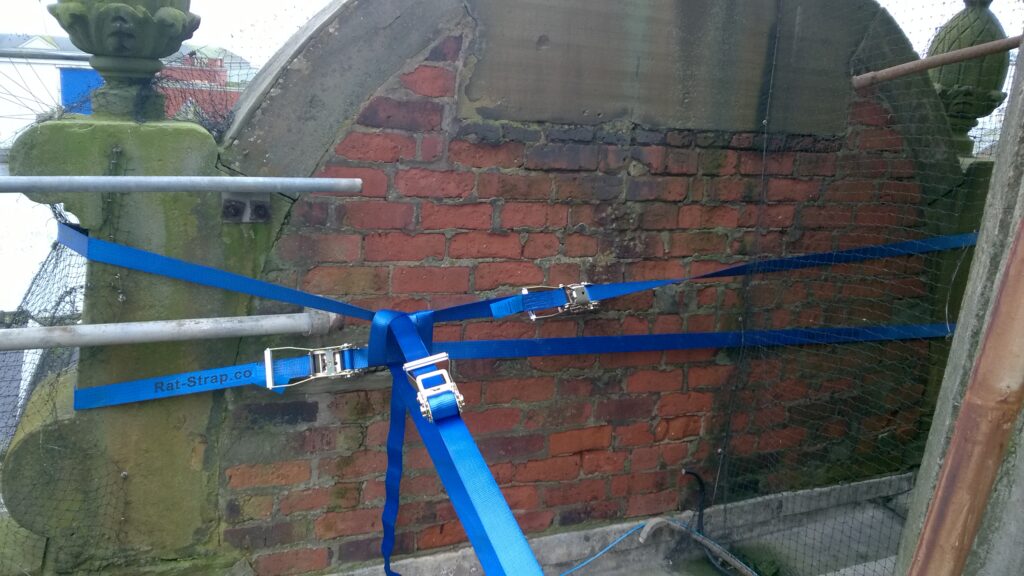

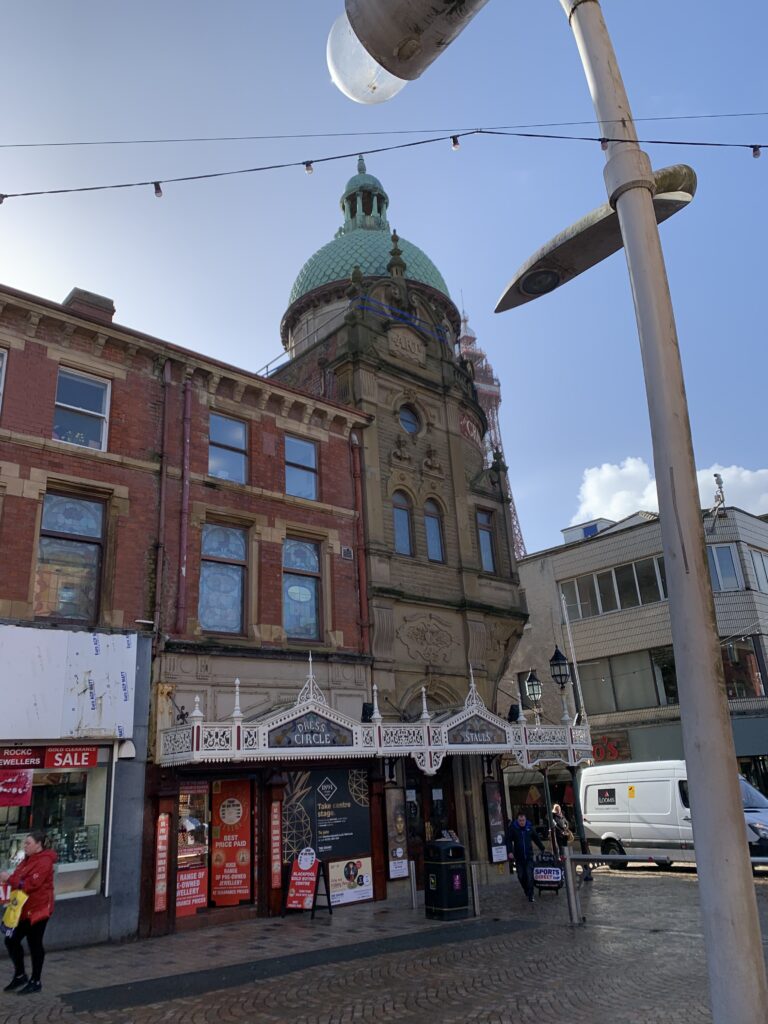
Adapted from “A Short History of the Grand Theatre” by Barry Band, Grand Theatre historian and Director of the Grand Theatre Trust Ltd. And “How the Grand was Saved” by A Burt Briggs (TD). Vice-President of the Grand Theatre Trust and Founder of the Friends of the Grand. Published in the pamphlet “Centenary Appeal: Blackpool Grand Theatre 1894-1994”.
MANY THANKS to Nick Moore and his fascinating History of Blackpool for some of the historical information used in this page. You can read it here
The Friends still a valuable and active asset today in the operation of The Grand Theatre.
Blackpool’s Grand Theatre Today…
Today, The Grand Theatre aims to appeal to all. You’ve only got to look at the eclectic offering of opera, ballet, quality drama, comedy and dance…there’s no theatre quite like it!
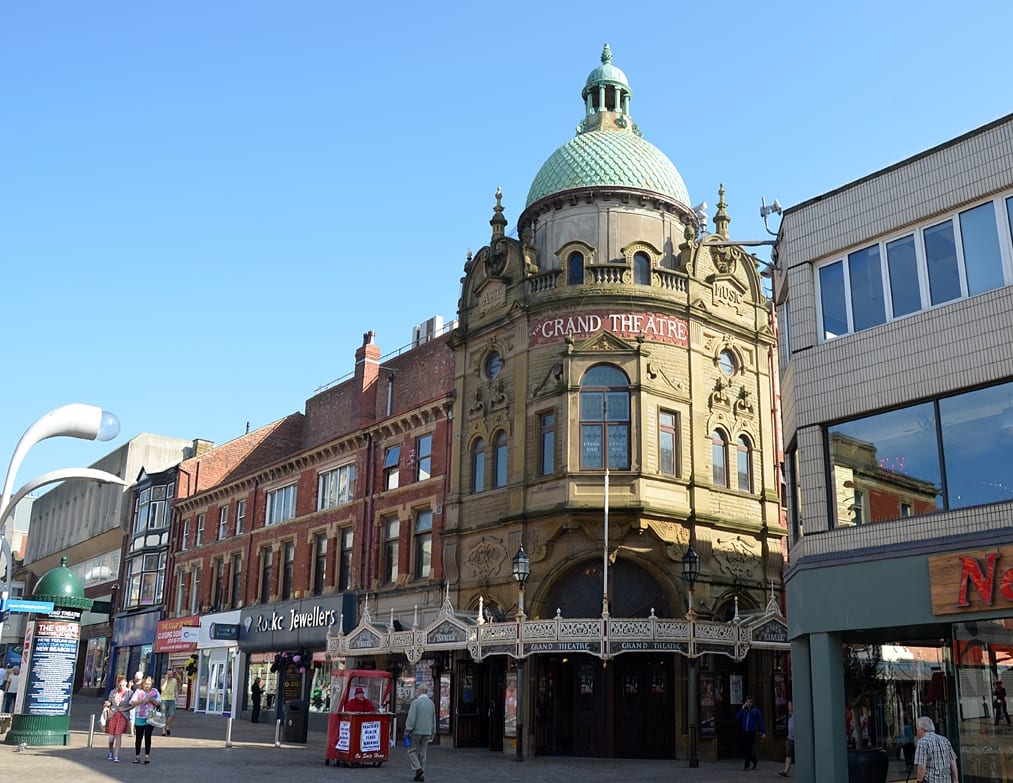
Now, it’s one of Britain’s premier heritage theatres.
- Listed Grade II* it’s in the top 8% of all listed buildings in England,
- It’s one of only thirty listed buildings in Blackpool,
- Also one of only nine large theatres listed Grade II* or above, which are north of London.
The Grand is owned by the Blackpool Grand Theatre Trust Limited. This is the organisation which reopened the theatre in 1981 following the efforts of a number of committed volunteers who saved the theatre from demolition. Restoration work has continued since – without ever closing the theatre.
Did you know? The capacity of the theatre during the opening week was reported as 3000. There was also standing room on all four levels. Today, the seating capacity is 1153.
This amazing space is a wonder of restoration and revival, presenting a full range of every performing artform. It’s Blackpool’s community theatre, Lancashire’s preferred opera house and Britain’s National Theatre of Variety.
Experience the History of The Grand Theatre
Has this article has whetted your appetite to learn more about the History of The Grand Theatre? Why don’t you join one of their Heritage Tours? They take place most months and take you from the top to the bottom of this beautiful building.

Find out the secrets and stories of the stunning Victorian theatre, and learn about the flamboyant theatre architect Frank Matcham. Explore the warren of staircases and hidden passages that lead to the dressing rooms, hidden quarters and beyond…
You’ll delve into areas not normally open or available to the general public and explore Blackpool’s hidden gem. Stand on the raked stage and observe the cantilevered tiers of circles, boxes and pit. Admire the complete visibility of every seat in the atmospheric house. Capture the atmosphere and charm of this beautiful old theatre on an unforgettable journey.
Would you like your own Grand Theatre?
Have you seen our online shop called Seaside Emporium where we sell our own original art? Live Blackpool is part of Visit Fylde Coast, independently published by The Rabbit Patch Ltd. We’re a design and creatives company right here on the Fylde Coast.
This is our original watercolour painting of the Grand Theatre – available framed or as a plain print. Follow the link and have a look around at both local scenes and traditional seaside views.
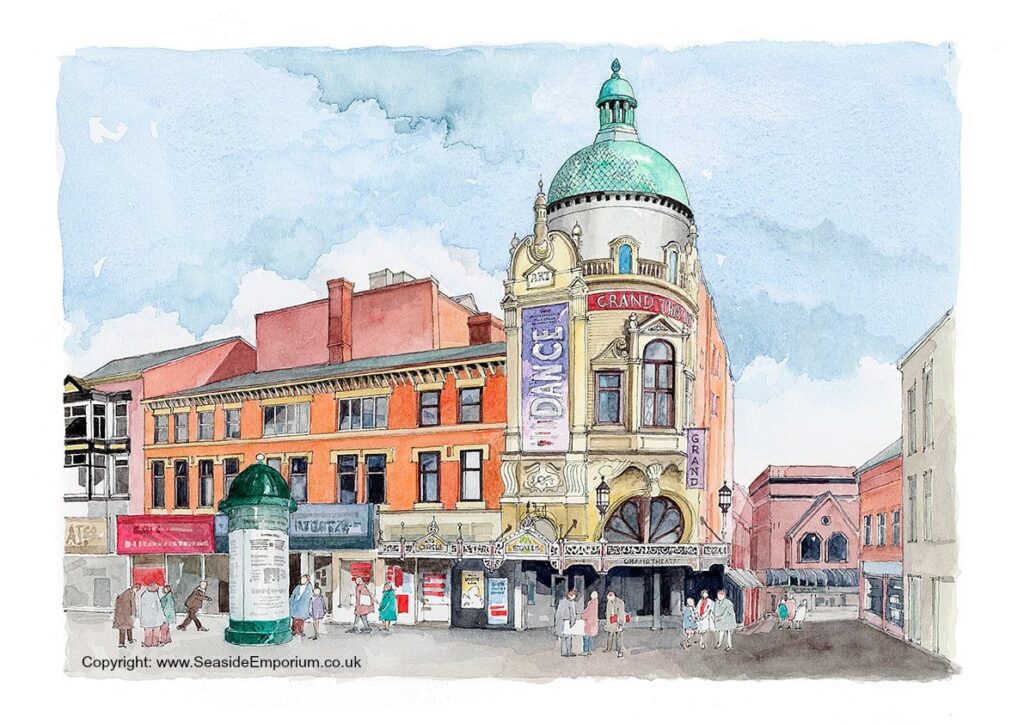
70 Fascinating Facts – History of the Grand
- Listed Grade II*, the Grand is in the top 8% of all listed buildings in England, and one of only thirty listed buildings in Blackpool.
- One of only nine large theatres listed Grade II* or above, north of London.
- The Grand Theatre is a product and symbol of the late nineteenth-century boom in theatre going and the expansion of live entertainment at Blackpool, Britain’s biggest show town after London’s West End.
- The exterior of the theatre is a visual landmark of the town centre; whilst inside, architect Frank Matchams decorations and four-tier 1,100-seat intimate auditorium creates an atmosphere of festive spirit for what is also a cultural landmark.
- Frank Matchams designed The Grand Theatre to be ‘ The best, prettiest and cosiest theatre possible’ (as Thomas Sergenson requested).
Work Begins
- The work on The Grand Theatre began in September 1893.
- The theatre took just nine months to build and cost £20,000.
- The Grand is one of more than 150 designed by Frank Matcham, the leading Victorian theatre architect. By the outbreak of the First World War, no significant town was without its theatre, or music-hall.
- Sadly, only some two dozen of Frank Matchams theatres survive till this day, with Grand being ‘Matcham’s Masterpiece’.
- The auditorium of the theatre is one of Matcham’s finest creations, combining intimacy with a sense of imposing spaciousness. He achieved this by stacking the audience vertically in three closely spaced, relatively shallow, balconies which curve well round the sides, separated from the proscenium by only one box on either side at dress circle level.
An Unobstructed View
- Frank Matcham used a steel frame and the cantilever system to support the Dress and Upper Circles and the Gallery at The Grand Theatre. So apart from the rear stalls, there are no columns to obstruct the view
- The Grand Theatre has eight boxes, including the Royal Box.
- The balconies are partly cantilevered and partly supported on iron columns.
- Deeply-cut Baroque plasterwork encrusts the balcony fronts at Blackpool Grand Theatre.
- The raked Proscenium stage at Blackpool Grand Theatre is just over 30 feet wide and 30 feet deep.
Paintings of the Muses
- The proscenium opening at Blackpool Grand Theatre has an imposing round arched frame with openwork plaster ‘frills’. The spandrels of the arch contain large paintings of the muses.
- The oval ceiling at Blackpool Grand Theatre is opulently decorated with painted panels of composers by Messrs Binns of Halifax.
- Back in 1894, when it first opened, the seats were covered in blue English velvet. They were changed to red colour in the 1970s. During refurbishment in 2007 they went back to the original colour.
- The two busts in the auditorium of The Grand Theatre are Handel (looking to the stage) and Shakespeare (looking to the audience).
- It can clearly be stated that the Grand Theatre represents one of the most complete and important Frank Matcham ‘survivors’.
Opened in 1894
- The Grand Theatre was opened on July 23, 1894, by Thomas Sergenson, Blackpool’s first successful theatrical manager.
- The Grand Theatre opened two months after the Tower.
- The theatre opened with a performance of Hamlet with Wilson Barrett, a leading actor-manager who had often appeared in Blackpool.
- On the opening night of The Grand Theatre the programmes were printed on perfumed silk. The perfume was called ‘Tower Bouquet’.
- When the theatre first opened, the seats cost 4 shillings (20p); 1 or 2 guineas (£1.05 or £2.10) for a box.
Standing Room on Four Levels!
- The Blackpool Gazette reported that the capacity of the theatre during the opening week was 3000 – as there was also standing room on all four levels. Today, the seating capacity is 1153.
- When the theatre was first opened, Blackpool Gazette reported that the gallery will provide accommodation for at least one thousand! Today, the seating capacity of the whole theatre is 1153.
- When the Grand Theatre first opened, smoking was allowed in the auditorium.
- Going to the theatre in the Grand’s early days was a much different occasion than today. Patrons in the grand circle and the stalls were expected to dress in an evening wear. They would not be admitted to those areas unless they were correctly dressed.
- Over the years, many famous people have appeared on Grand Theatre’s stage. In 1902, the Grand was rented for a political rally – the main speaker was the MP for Oldham, Winston Churchill.
More Seats in the Stalls
- In 1901 Thomas Sergenson decided to put in more seats in the stalls, taking space from the pit area in the centre, where he could charge a top price for them (which was then one shilling – 5p).
- Lillie Langtry, who billed herself Mrs Langtry, starred at The Grand three times.
- In 1909 Thomas Sergenson sold the theatre for a handsome £47,500 to the Blackpool Tower Company, who ran the Grand for the next sixty-two years.
- The Tower Company completely repainted, redecorated and reupholstered the Grand from floor to ceiling. Some areas were modernised and reconstructed, and improvements were made to the stage lighting.
- In the 1920s the theatre began to be used by top West End producers for British premieres and for forty years many plays and musicals were seen at the Grand ‘prior to London’.
Live Shows in the Holidays
- After the success of talking pictures, the Grand in the 1930s was a cinema in the winter and staged ‘live’ shows during the holiday season.
- In 1939 war was declared and the Government ordered the closure of all theatres. The Grand was only closed for a week.
- During World War Two, Blackpool was a safe haven from German bombing and many great stars and shows came to the Grand.
- In 1940 theatre was nearly destroyed by a fire when a night shift of cleaners found a section of seating alight in the gallery caused by a cigarette end, but the fire brigade quickly extinguished the blaze.
- In October, 1942, Noel Coward premiered and appeared in two of his plays – Present Laughter and This Happy Breed. He threw in Blithe Spirit for good measure!
A Glittering Decade
- The prestige of the Grand continued through the 1950s, which was a glittering decade in spite of the growing impact of television.
- By the early 1960s theatres across Britain were closing due to loss of audience to television. The Grand survived longer than most, thanks to the backing of the Tower Company.
- The shortage of good shows, coupled with declining ticket sales, forced a policy of winter closure from 1963 to 1972.
- At the end of 1968, the Tower Company’s parent group, EMI, took over the Grand – with plans to use it as a bingo hall.
- In the mid 1960s, the theatre was included in a town centre redevelopment plan. The result of this was that in July 1972 the EMI applied for permission to demolish it. In its place they proposed a department store.
Listed Grade II
- By 1972, following an application to the Department of the Environment, the theatre was listed as a Grade II building.
- In 1973 local theatre lovers banded together to resist the application to demolish the theatre. The Friends of the Grand was formed specifically for the purpose.
- The Friends of The Grand put forward a case which persuaded the Inspector that it would be wrong to allow the demolition of the theatre.
- In 1975, after years of disuse, it became obvious that the EMI were planning to turn the Grand into a bingo hall. It staged bingo for three years.
- After the purchase of the theatre by Blackpool Grand Theatre Trust Limited, in September, 1980, dozens of Friends helped to refurbish the dressing rooms and backstage areas.
Reopening
- The Grand was reopened on Monday March 23, 1981, by Timothy West and Prunella Scales in the Old Vic production of Shakespeare’s The Merchant of Venice.
- In May 1981, the theatre had a prestigious two-week visit by the D’Oyly Carte Opera Company with their Gilbert and Sullivan repertoire, and on May 29 the ultimate theatrical honour of a Royal Variety Performance in the presence of HRH The Prince of Wales.
- Since 1981, restoration work has continued without ever closing the theatre. Significant work to date has included a reinstatement of the cast iron, glazed marquee on the theatre’s entrance, the addition of small shop-kiosks on the west elevation (that provide much needed income), the cleaning and repairing of stonework and the dome, the creation of a new Stalls Bar, covering of Matcham Court to make an all-weather patio, restoration of beautiful stained glass windows that are now triple glazed, and several interventions to improve disabled access and provide new lavatories.
- In 1988 under the supervision of Neil Thompson, the deputy general manager and technical manager, a five year programme of refurbishment was instigated. It included, among others, the conversion of the annexe to an 80-seat modern studio theatre with four refurbished dressing rooms, new offices, toilets and the installation of a lift.
- During the restoration in 2000 when the cradle first went up, 2 tons of dust and dirt was removed from the ceiling. The original colours were actually preserved by a triple layer caused by the dust, tobacco smoke (smoking was allowed in all theatres) and the varnish which had turned yellow.
A Grand Restoration Scheme
- In 2001, a three-phase Glorious Grand Restoration scheme and public appeal was launched. Phase One was completed in 2002: the (partial) renovation of the auditorium, including re-gilding of ornate plasterwork, restoration of ceiling and proscenium arch paintings, and new house curtains.
- On Friday 18th January 2002 the Glorious Grand was finally revealed at a Gala Celebration Evening with The Cala Rosa Opera Company performing The Mikado.
- The programmes for The Mikado (opening night after the restoration 2002) each included a piece of the original curtain.
- In 2004 till 2006 phase two of The Glorious Grand Appeal, Sam Lee Appeal was launched with a special performance of Boogie Nights. Fundraising events continued to help bring the amount raised to £ 250.00.
- In 2007 Grand Theatre closed for five weeks for refurbishment.
Roll out the Carpet
- During the refurbishment in 2007 the carpet was replaced . It was commissioned by the Grand Theatre with support of the Theatres’ Trust on an original design from 1894.
- During the refurbishment in 2007 over 1700 square-metres of carpet have been laid with precision to allow the pattern repeat to follow throughout the theatre.
- During the refurbishment in 2007 a total 4000 metres of wiring has been used to update the theatre’s various installations. This would stretch from the Grand Theatre to Pleasure Beach, Blackpool.
- After the refurbishment in 2007 the theatre now houses wider and correctly raked seats in the stalls and the dress circle.
- The base of the seats that were installed during refurbishment in 2007 have a comforting 10cm cushion nearly double the previous seats and will last an incredible 20 years rather than 10 years at average occupancy.
Refurbishing Chairs
- In total 22 screws hold each seat that were installed during refurbishment in 2007 together and to the floor, and weigh an incredible 10 kilos.
- An unbelievable 31,000 screws were used during refurbishment in 2007 to resurface the floor and position the seating.
- A total 4000 metres of wiring has been used to update the theatre’s various installations during refurbishment in 2007. This would stretch from the Grand Theatre to Pleasure Beach, Blackpool.
- For Phase Three restoration that is planned, there are more excitements ahead, as we investigate circulation spaces, the original layout of the vestibule and mosaic flooring, the relationship of the theatre to the shops on Church Street, and much more!
- Charlie the ghost is said to haunt the Upper Circle, after throwing himself off the edge in late Victorian times. He was in love with a ballerina but she wasn’t in love with him.
While you’re here…
Go to the homepage of the Live Blackpool website for the latest updates.
Love the Fylde Coast? Sign up for your email newsletter. Packed full of interesting things it arrives in your inbox all 52 weeks of the year.
Join us on Facebook at our Visit Fylde Coast Facebook Group and follow us on Twitter @visitFyldeCoast
Plus hundreds of videos to watch on our YouTube channel – from all over the Fylde Coast!
Booking a stay? Pick a safe, clean and legal place to stay, at the very best price. Book with the Visit Fylde Coast and StayBlackpool guide.


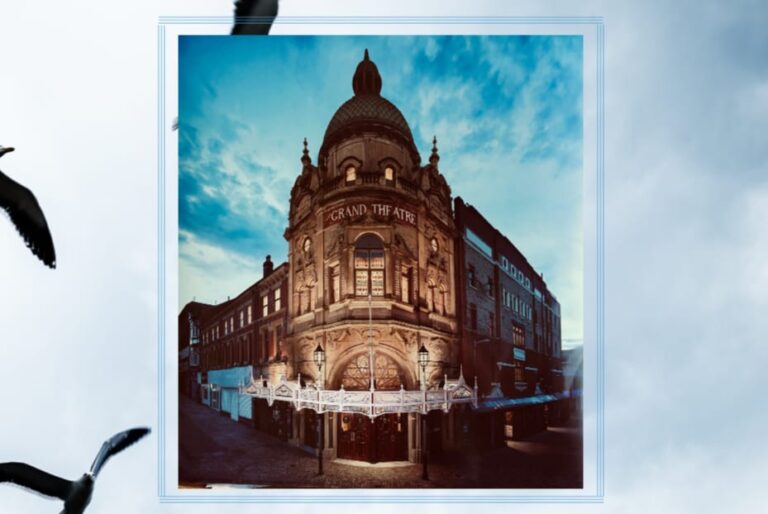







all the sites talk about the 16 composers’ names that appear in the room, but none say which composers are named!